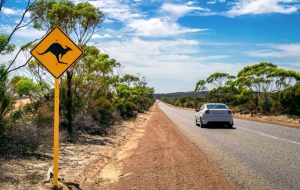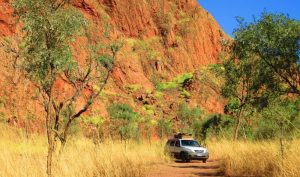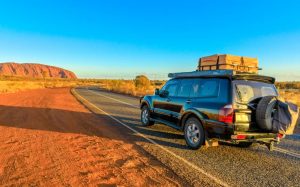If you are looking for wide-open spaces, ancient mountain ranges, and a break from the overall business of life, a trip through the Australian Outback could be just what you want.
Each year, hundreds of thousands visit various regions throughout the vast expanse of the Outback. The majority of these trips occur without incident, but the area’s pull and popularity should not overshadow the potential for danger. However, with some planning ahead, you can safely enjoy an unforgettable road trip through the Outback.
What Car Should I Drive on an Outback Road Trip?
Part of the answer to this question depends on your route. Are you planning a drive across the Nullarbor, which is a sealed road? Or are your sights set on going off of the beaten path for a journey on a dirt track?
For sealed roads, a sturdy two-wheel-drive car should serve you well. If you plan to take the road less travelled, four-wheel or all-wheel-drive models are your best bet.
Whatever type of car you choose, you should opt for a vehicle with high clearance and great suspension. (Especially if you are heading to remote locations.)
What Should I Check on My Car Before My Trip?
Car maintenance and health checks are essential regardless of where you drive. However, before you venture into the Outback, you (or a mechanic) should examine the following,
- Tyre condition and pressure
- Radiator coolant level
- Condition of hoses- be sure to check clamps for any leaking
- Fan or serpentine belts should be tight without any visible wear
- Change oil or top off if necessary
- Check all fluid levels and fill them according to your car manual directions
- Check air and fuel filters and replace them if needed
- Check Breaks
- Test all lights and indicators for bulbs that need to be replaced
- Replace frayed windshield wipers and top off wiper fluid reservoir
What Should I Keep in My Car on a Road Trip Through the Outback?
Even though you will find no shortage of adventure in the Australian Outback, you may experience shortages of several other necessities. Remember that it is better to have something you need than to wish you have it.
Water – A lot of clean drinking water is a must-have, and it is impossible to overstate how important it is, especially if you find yourself in a survival situation. If possible, take a clean 20L container with water. You should bring more than you think you will need.
A Well-Stocked Supply of Snacks – As is true with water, having excess snacks in your car will not harm you. Non-perishable snacks are your best bet. Avoid very salty snacks as those will increase your thirst.
Commonly Used Spare Auto Parts – You mustn’t underestimate the scarcity of many products that are readily available in urban areas. Packing a few parts can be the difference between a minor inconvenience and waiting for days to get what you need for a repair. Examples of these include,
- Coolant
- Duct Tape
- Fanbelts
- Fluids and filters
- Fuses
- Inflated Full-Size Spare Tyre
- Jack and Wrench
- Multipurpose tools
- Oil
- Radiator Hoses
- Screws of Various Sizes
- Water
- WD40
- Wiper Blades
- Wire
A Way of Emergency Communication – There are large segments of the Outback where you will have no signal for your cell phone. You have other options. Many people heading through the Outback will carry a satellite phone or opt to get a DeLorme personal locator beacon.
Downloaded Maps and Paper Maps – Because cell phone service is spotty in many regions, you should not rely on your phone’s apps to guide you through the Outback. Take the time to download the maps and directions so you can access them in areas that have no mobile phone service. Bringing along a few paper maps is a wise idea as well. By expecting the unexpected, you can save yourself a great deal of frustration.
Ways of Signaling Distress – Focusing on ways to prevent a breakdown and having the means to help yourself are crucial. However, there are times when making your car as visible as possible to aid rescue crews can save your life.
- Reflective materials to mark your vehicle
- White or brightly coloured fabric to attach to your car
- Luminescent products to make your auto stand out at night
Car Essentials – Whether you are travelling across the country or just to gran’s house, you should have the following items along for the ride.
- Information such as driver’s license, insurance information, medical conditions, and emergency contacts
- Repair equipment like jumper cables, windshield wiper fluid, tyre pressure gauge, jack and spare tyre
- Emergency supplies like a first aid kit, nonperishable food, drinking water, and flashlights
- Chargers for mobile devices
- Seasonal protection from the elements including safety blankets, rain jackets, hats, gloves, and sunglasses
Safety Tips for Driving Through the Australian Outback
Common sense may dictate several of these suggestions, but thinking is close to impossible if you are in a difficult or frightening situation.
- Share your itinerary and give vehicle license and description to friends or family members.
- Write a plan of action to take in various emergencies.
- Plan on filling your tank at every petrol station you encounter. Stations can be few and far between, especially in more remote areas. Avoid taking a chance of running out of fuel.
- Drive with your lights on even during the day. You want to be as visible as possible to road trains and large trucks
- Avoid driving through the Outback at night. Road hazards and animals are much harder to spot after dark. If you cannot avoid driving at night, move slower than usual and be vigilant.
- Do not swerve for animals when travelling at a high rate of speed, especially on unsealed roads. This can easily cause you to careen off the road and seriously injure yourself or your companions.
- Take extra care if overtaking road trains. Make sure you have a great deal of clear road ahead of you and never try to pass on curves, going up inclines, or any time you do not have a clear view ahead.
- If possible, avoid trekking across the outback during the summer.
A road trip through the Australian Outback can be a wonderfully enriching and exciting experience. By taking the time to plan, you can avoid any problems that could turn your dream trip into a nightmare.



